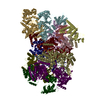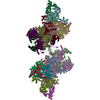+Search query
-Structure paper
| Title | Mechanism of replication origin melting nucleated by CMG helicase assembly. |
|---|---|
| Journal, issue, pages | Nature, Vol. 606, Issue 7916, Page 1007-1014, Year 2022 |
| Publish date | Jun 15, 2022 |
 Authors Authors | Jacob S Lewis / Marta H Gross / Joana Sousa / Sarah S Henrikus / Julia F Greiwe / Andrea Nans / John F X Diffley / Alessandro Costa /  |
| PubMed Abstract | The activation of eukaryotic origins of replication occurs in temporally separated steps to ensure that chromosomes are copied only once per cell cycle. First, the MCM helicase is loaded onto duplex ...The activation of eukaryotic origins of replication occurs in temporally separated steps to ensure that chromosomes are copied only once per cell cycle. First, the MCM helicase is loaded onto duplex DNA as an inactive double hexamer. Activation occurs after the recruitment of a set of firing factors that assemble two Cdc45-MCM-GINS (CMG) holo-helicases. CMG formation leads to the underwinding of DNA on the path to the establishment of the replication fork, but whether DNA becomes melted at this stage is unknown. Here we use cryo-electron microscopy to image ATP-dependent CMG assembly on a chromatinized origin, reconstituted in vitro with purified yeast proteins. We find that CMG formation disrupts the double hexamer interface and thereby exposes duplex DNA in between the two CMGs. The two helicases remain tethered, which gives rise to a splayed dimer, with implications for origin activation and replisome integrity. Inside each MCM ring, the double helix becomes untwisted and base pairing is broken. This comes as the result of ATP-triggered conformational changes in MCM that involve DNA stretching and protein-mediated stabilization of three orphan bases. Mcm2 pore-loop residues that engage DNA in our structure are dispensable for double hexamer loading and CMG formation, but are essential to untwist the DNA and promote replication. Our results explain how ATP binding nucleates origin DNA melting by the CMG and maintains replisome stability at initiation. |
 External links External links |  Nature / Nature /  PubMed:35705812 / PubMed:35705812 /  PubMed Central PubMed Central |
| Methods | EM (single particle) |
| Resolution | 3.3 - 8.2 Å |
| Structure data | EMDB-13978, PDB-7qhs:  EMDB-13988: S. cerevisiae CMGE dimer nucleating origin DNA melting EMDB-14439, PDB-7z13: |
| Chemicals |  ChemComp-ATP:  ChemComp-ZN:  ChemComp-MG:  ChemComp-ADP: |
| Source |
|
 Keywords Keywords | REPLICATION / DNA replication / helicase / initiation / DNA origin |
 Movie
Movie Controller
Controller Structure viewers
Structure viewers About Yorodumi Papers
About Yorodumi Papers








